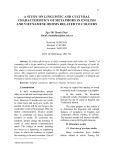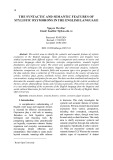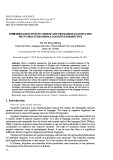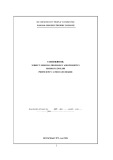
Urban Wastewater Treatment Regulation in the European Union 5
rTo establish a technical and financial programme for the implementation of the
Directive for construction of sewage networks and wastewater treatment plants
addressing treatment objectives within the deadlines set up by the Directive.
Regulation requires ensuring that:
rAll urban wastewater generated in agglomerations discharging into urban sewer
systems and treatment plants have prior regulation or specific authorization.
rIndustrial wastewater discharging into urban sewage networks is based on prior
regulation and/or specific authorization; pretreatment requirements, ensuring that:
(a) treatment plant operation and sludge treatment will not being impeded;
(b) it will be no adverse effect to the environment (including receiving waters); and
(c) safe disposal of sewage sludge.
rFood-processing industries have prior regulation and/or specific authorization and
permit system.
rAll urban wastewater generated in agglomerations with more than 2000 p.e. are
supplied with collecting systems, and the capacity of those is such that it ensures to
collect all urban wastewater taking into account normal local climatic conditions
and seasonal variations.
rNational authorities are taking measures in relation to collecting systems to limit
pollution of receiving waters from storm water overflows under unusual situations,
such as heavy rain.
rWastewater treatment is provided for all these agglomerations, at the level of
treatment specified and within the required deadline:
– The basic rule for the level of treatment is secondary (i.e. biological) and more
stringent treatment in sensitive areas (i.e. with nutrient removal in particular and
other pollutant affecting the quality of specific use of the receiving water).
– For certain discharges in coastal waters treatment might be less stringent, i.e.
primary, under specific conditions and subject to agreement of the Commission.
– For agglomerations with population equivalent of less that 2000 but equipped
with collecting system, ‘appropriate treatment’ has to be provided, i.e. treat-
ment that ensures to meet the relevant quality objectives of the receiving
waters.
rTechnical requirements on design, construction, operation and maintenance for
wastewater treatment plants treating urban wastewater are maintained ensuring
adequate capacity of the plant and treatment of urban wastewater generated in
agglomeration taking into account normal local climatic conditions and seasonal
variations.
rEnvironment is protected from adverse effects of the discharge of wastewater.

6Wastewater Regulation
rEnvironmentally and technically sound reuse or disposal of sewage sludge is sub-
ject to general rules, registration or authorization, and requirements of specific
inter-linked directives for agricultural reuse (86/278/EEC), incineration (89/429/
EEC and 89/369/EEC), and landfill (99/31/EC), are respected. The disposal of
sludge to surface waters is banned.
Monitoring requires ensuring that:
rappropriate monitoring capacity of parameters to be monitored;
rproper analysis of samples by using standard methods;
rtimely frequency of monitoring for:
– monitoring of discharges from urban wastewater treatment plants; and
– monitoring of waters receiving those discharges.
Information and reporting requires ensuring that:
rAdequate cooperation and exchange of information with other member states in
cases where discharges of wastewater have a transboundary effect on water quality
of shared waters.
rAdequate reporting procedure and databases for the requests from the Commission
for information on:
– transposition of the directive into national legislation, implementation pro-
grammes, situation reports on the disposal and reuse of urban wastewater and
sewage sludge;
– status of collecting systems, efficiency of treatment plants (i.e. treatment level
and monitoring results) and water quality of receiving waters;
– status of discharges from food-processing industry to surface waters.
rThat the public has access to relevant information and that relevant authorities of
member states every 2 years will publish status reports to the public on the status
of wastewater collection and treatment and disposal or reuse of sludge.
The Directive is based on a number of principles that have been laid down in
the Treaty of the European Union, such as precautionary, nondeterioration, sustai-
nable use of water resources, and principle of subsidiary. The implementation of
the Directive should not result in deterioration of the current level of environmental
protection offered by the member states. Furthermore, the level of protection may be
even stricter than the Directive requires in case there is a need to fight deterioration of
quality of receiving water bodies and to try to restore waters affected by wastewater
discharges.

Urban Wastewater Treatment Regulation in the European Union 7
Parameters and parametric values in the Urban Wastewater Treatment Directive
The Directive regulates the main conventional pollutants in treated wastewater
discharges from treatment plants. These are: total suspended solids, chemical oxygen
demand, biochemical oxygen demand, total nitrogen and total phosphorus. However,
other parameters shall also be considered especially when making the assessment of
receiving waters to designate sensitive areas and to achieve water quality objectives
of water bodies.
The Directive sets up emission limit values for the above-mentioned parameters
or by showing treatment efficiency (calculating it through incoming and outgoing
pollution load of each regulated parameter). Either the concentration of a pollutant
at the discharge point or the reduction rate of pollution load shall apply.
The Directive sets up a general requirement for:
rTreated urban wastewater reuse to ensure that there will be no adverse effect to
the environment. However, there are no detailed regulations on treated wastewater
quality for the purposes of its reuse for various economic activities.
rThe usage of sewage sludge indicating that it shall be re-used whenever appropriate
having no adverse affect on the environment.
However, there are no precise provisions in this Directive on setting emission
limit values or quality standards to be achieved when having activities of the reuse
of these end-products from wastewater treatment process. These two aspects are
partly or indirectly regulated by the other EU pieces of legislation.
Sampling and monitoring
The Directive requires establishing a monitoring and inspection programme for
compliance assessment of discharges from urban wastewater treatment plants and
for assessing the amounts and composition of sludge.
The Directive defines minimum monitoring requirements for treated wastewater
by setting sampling frequency, which is dependent on the size of urban wastewater
treatment plant. The maximum number of noncomplying samples is also defined in
the Directive.
The Directive also defines the standard laboratory methods to be used for the
analysis of the samples.
Quality control and assurance
Member States have to ensure laboratory capacities, and laboratories must use the
methods specified in the Directive Annex I and to be subject to regular quality

8Wastewater Regulation
control. Accreditation schemes for laboratories are the means of constantly ensuring
quality control. Quality control is restricted to the analytical laboratory methods to
be used for the analysis of samples. Member States need to have some quality control
system in place in the approved laboratories for wastewater analyses.
Taking into account the principle of subsidiary, Member States have a duty to
organize and self-control the Directive implementation by setting adequate urban
wastewater collection systems and treatment facilities as well as controlling wastewa-
ter pollution level through monitoring of urban wastewater against Directive require-
ments.
The control of annual monitoring results of treated urban wastewater is a duty of
Member States to check against the Directive requirements. The data shall be stored
in the Member State to analyse trends and impact of discharged wastewater to the
environment and to ensure the reporting of the results to the Commission to check
the implementation status. Member States have to provide requested data within the
deadline of 6 months.
1.1.1.3 Other Related Legislation on Other Types of
Wastewater Except Urban
Implementation of the main UWWT Directive is closely linked with other EU
legislation, in particular:
rWater Framework Directive 2000/60/EC;
rNitrates Directive 91/676/EEC;
rIntegrated Pollution Prevention and Control Directive 96/91/EC;
rDangerous Substances Directive 76/464/EEC and its seven daughter directives;
rSewage Sludge Directive 86/278/EEC;
rLandfill Directive 99/31/EC;
rIncineration Directives 89/429/EEC and 89/369/EEC;
rEnvironmental Impact Assessment Directive 85/337/EEC;
rDirective on Access to Environmental Information 90/313/EEC;
rReporting Directive 91/692/EEC and Decision 94/741/EEC;
Particularly relevant issues in these directives concern:
rThe provisions under UWWTD are the integral part of basic measures in the
programme of measures to be included into river basin management plans under

Urban Wastewater Treatment Regulation in the European Union 9
WFD, without any change of deadlines set under UWWTD for the EU-15 and in
line with the transitional periods set up in the Accession Treaty for the EU-10.
rThe provision of adequate facilities for either incineration or landfill of sewage
sludge.
rThe quality requirements for sewage sludge used in agriculture.
rCertain size large installations of food-processing industries covered by UWWTD
also fall under requirements of the IPPCD (i.e. for some installations the require-
ments of both directives overlap). It should be borne in mind that IPPC Directive
sets requirements for application of a combined approach (as the WFD does) of
emission controls and water quality standards. In each particular case the more
stringent approach (setting more stringent treatment standards for wastewater) to
reach certain water quality objectives applies.
Integration of EU water legislation does not only imply compliance to the require-
ments of various related directives but will also involve harmonization and streamlin-
ing of monitoring and reporting requirements. Reporting requirements will have to
address compliance and the state of, and trends in, the quality of aquatic environment
through implementing prevention measures – decrease generation of wastewater at
the source, sustainable management of water resources as well as when wastewater
is generated – ensuring the adequate required wastewater treatment. The process on
harmonization of reporting has been started with the concept and the ambitious goal
to have an integrated reporting system in Europe, the so-called Water Information
System for Europe (WISE).
1.1.1.4 Conclusions
It should be underlined that the implementation of the UWWTD ranks amongst the
most challenging and expensive tasks throughout the range of EU legislation. This
is why early and careful consideration of the environmental and technical aspects of
the Directive is of significant importance.
Much of the environmental legislation in the EU is interrelated, both within a spe-
cific sector (e.g. water sector) and between sectors. Consequently, individual Com-
munity legal acts cannot be implemented in isolation. For example, implementation
of UWWTD 91/271/EEC in advance of another directive can lead to environmental
problems, e.g. increased volumes of sewage sludge which then need to be disposed
of in accordance with Waste Framework Directive 75/442/EEC. Furthermore, the
main measures to implement the UWWTD are one of the main components of the
Programme of measures of River basin management plans required by the Water
Framework Directive. However, complete implementation of UWWTD is only a
minimum requirement to achieve good ecological status of surface waters required
by the WFD 2000/60/EC.






![[Chuẩn nhất] Ngữ Pháp Cơ Bản: Sự Phối Hợp Thì (Sequence of Tenses) trong Tiếng Anh](https://cdn.tailieu.vn/images/document/thumbnail/2025/20250311/tinhtamdacy000/135x160/1246685478.jpg)





![Tài liệu Từ vựng tiếng Anh Trung cấp [mới nhất]](https://cdn.tailieu.vn/images/document/thumbnail/2025/20250913/nguyentuan250421@gmail.com/135x160/99491757910839.jpg)
![Tài liệu Từ vựng Tiếng Anh theo chủ đề [mới nhất]](https://cdn.tailieu.vn/images/document/thumbnail/2025/20250913/namdhuet@gmail.com/135x160/83251757753810.jpg)



![Tài liệu Từ vựng tiếng Anh cho bé [chuẩn nhất/mới nhất]](https://cdn.tailieu.vn/images/document/thumbnail/2025/20250731/huadaithesang2509@gmail.com/135x160/18631754013896.jpg)








